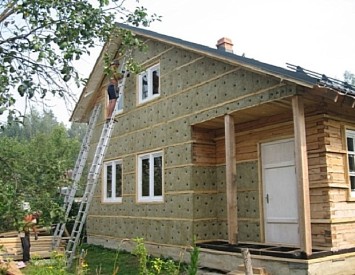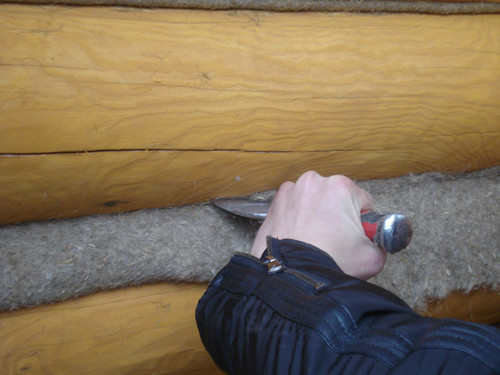Recently, a tendency has been traced more clearly - people in an effort to approach nature move from city multi -storey buildings to private wooden cottages. Downshift is explained not only by fashion and subconscious traction to the natural and natural, but also by a well -founded desire to live in a healthy atmosphere. It is known that wood is a natural heat insulator, but this does not mean at all that the house built from this material does not need insulation. Today we will talk about how to insulate a wooden private house with your own hands outside and inside.
Content
The choice of materials
The practice of building wood from wood has millennia, and earlier for insulation, people used exclusively natural materials: dad, moss, straw, etc. Unlike old solid buildings from whole logs, modern wooden cottages are easy and need for thorough insulation. The best option, according to all experts, is external insulation, but in some cases the internal is permissible. In any case, it is necessary to conduct a study and identify which areas require special attention. So, if the house stands on stilts, through an unsplendous floor, drafts will constantly walk, if the base of a different type, it is necessary to insulate the foundation of a wooden house with your own hands, otherwise it will go to 40-50% of heat through it.
The second zone requiring the most close attention is the roof-up to 50-60% of heated air can go through it. The article will help you with this "DIY roof insulation". And finally, the walls of the house occupy the largest area, and besides, they are subject to wind loads, and it is impossible to neglect their insulation. Thus, several stages of work can be distinguished: insulation of floor, roof and walls. To save, you can use the old proven "grandfathers" methods of hemp using sawdust mixed with earth or clay, moss, jute, hemp, pacley. The floor can be insulated with expanded clay or ecowide.
To qualitatively insulate a wooden house with your own hands, you can use any materials, but it is advisable to focus on their naturalness, otherwise the whole point of environmental safety of the home will be lost. Also in wooden houses there is a great risk of rodents, so it is better if the insulation is quite strong or “tasteless” for mice. Also, he should not interfere with the ferry, otherwise the wood will begin to prohibit and rot. Also, do not forget about fire safety. Given all of the above requirements, it turns out that a wooden house can be insulated with ecowine or stone cotton wool, expanded clay or sawdust. Foam and its derivatives like polystyrene foam and polyurethane foam are better not to use, since they are non -emotional and do not pass water vapors.
Technology of insulation
The insulation of a wooden house is necessary not only to maintain a comfortable microclimate inside and saving fuel (electricity), but also to extend the life of internal coatings, furniture and structures that form the house itself. So, if changes in temperature and humidity are constantly observed inside, wooden elements will narrow and expand, begin to rot and deteriorate much earlier than the due date. To prevent this, first of all, it is necessary to pay attention to places with the largest heat loss: floor and roof.
Insulation from the outside
Before warming the wooden house outside with your own hands, you need to prepare all the tools and materials. If the house is two- or three-story, one staircase is not enough- you need to build construction forests. It is optimal to use stone cotton wool as a heater, since it copes with its task, is not subject to corruption with rodents and does not prevent moisture microcirculation. The obvious advantage of the material is the inappropriation of fire and simple installation.
How to insulate a wooden house with your own hands (with video):
- Start working in warm and dry weather. Treat the outer surface of the wooden wall with an antiseptic antifungal agent. Agree, it will be a shame if mold or insect parasites starts in the just insulated walls. Pay special attention to the ends of the logs and Brusiev, since they are most defeated by decay. Cover the surface with an antiseptic in two layers and leave for drying for a couple of days.
- Before laying thermal insulation material, it is necessary to attach vapor barrier. To do this, you can use a special membrane or peramin. If you decide to purchase a vapor barrier membrane, it should be mentioned that it is one -sided and bilateral. In the first case, one side will be glossy, the second - vile or porous. The glossy surface should be turned to the insulation, porous - to the wall. For fixation, use a furniture stapler.
- To lay thermal insulation, you need to make a frame of wooden racks, on which the first layer of insulation will be attached. To do this, a crate of 40x40 mm wooden beams is built from the outer part of the wall, placing them at a distance of 3-5 cm less than the width of the heat-insulating plate. This is necessary in order to squeeze the insulation as tightly as possible, and so that it stays inside without any additional fixation.

- Attach mineral wool on top of the vapor barrier, sticking it with force between the bars of the crate. Additionally, you can fix the insulation with anchor nails.
- Then build another crate, but already in the perpendicular direction in relation to the first (if the first crate bars were vertically, now they need to be fixed horizontally, and vice versa). The second layer of insulation, laid perpendicular to the first, will reliably protect the house from drafts and the slightest bridge of the cold.
- Next, it is necessary to protect the insulation from moisture, which can penetrate through the lining of the facade. To do this, attach a plastic film with a thickness of 100-200 microns or cutters of roofing material on top. For fixation, use wide tape, overlapping the cuts over 15-20 cm.
- So that the moisture falling under the sheathing can quickly evaporate, it is best to equip a ventilated frame. To create it, you will need exactly the same bars as for the crate. Blue them so that a gap of 4-5 cm remains between the insulation and the decorative facade. Attach them with self-tapping screws to the lower frame. If the walls of the house are slightly curved, use a perforated suspension for the profile - it will make it possible to adjust the distance to the frame. If you make a trim with corrugated board or metal siding, instead of bars, you can use a plasterboard profile.
- When performing the facade, make sure that there are no cracks left through it, through which moisture could penetrate inside.
Summarizes the instruction of the video on how to insulate a wooden house outside with your own hands:
Useful advice: in most cases, mineral wool plates with a thickness of 5 cm are used for insulation of wooden houses from the outside. The bars from which the crate will be built should be approximately the same thickness (better exactly the same).
Insulation from the inside
Before telling how to insulate a wooden house from the inside with your own hands, I would like to note that this method is undesirable and can be used only in cases where external insulation is unacceptable for some reason. Internal insulation is inconvenient not only in that it takes away the useful area of \u200b\u200bthe walls, but also because it moves the dew point inside the casing. This means that the wall that is not insulated outside begins to freeze, the cold moves deeper inside, and when it encounters the back of the insulation attached from the inside of the house, condensation appears due to the difference in temperatures.
It is much easier to insulate the ceiling in a wooden house with your own hands, gender or foundation. For this, you will not need special equipment, and working inside is more convenient than on the street (you can do it in any weather).
There are several thermal insulation techniques for the internal walls of the house depending on the heater used:
- Warm seam - such sealing seams and joints is used in cases where the inner surface of the wooden wall is preserved in its original form, that is, without decoration with decorative plaster and other materials. A warm seam significantly reduces the thermal conductivity of the masonry. Syilicon, rubber, latex or acrylic basis, as well as traditional materials like laziness, pacli, linen burning, can be used as a heater. Such insulation can easily be carried out with your own hands without special skills, it does not violate the natural attractiveness of wooden masonry, does not violate the microcirculation of air and moisture inside the room. Also, it is impossible not to note the economic benefit with fairly high performance indicators.
- Mineral wool - this material is suitable for both external and internal insulation of walls, ceiling, skewers and ceilings of a wooden house. First, in the wall, you need to smear all the cracks with a sealant and treat the surface with an antiseptic, then build a crate, as described above, and act in the same way until the finish. In this case, she will need several other materials: wooden panels, lining, drywall, plaster, etc.
- Foam - this material is very rarely used for insulation of wooden houses, since it does not pass steam, which inevitably leads to the formation of condensate inside the wall. However, if you correctly organize hydro- and vapor barrier layers, this technology will completely protect the house from frosts and save, since the foam itself is very inexpensive. Working with it is easy and simple, and low thermal conductivity with a small thickness of the material makes it possible not to sacrifice free space for the benefit of insulation, as in the case of mineral wool.
- Sprayed thermal insulation is a relatively new way of insulation of walls from the inside and outside. Unfortunately, this cannot be done with your own hand, since a special equipment is needed for the application (spraying) of thermal insulation material on the wall. As a result, an absolutely seamless coating is formed, which does not pass moisture or cold, but does not prevent the ferry.
To insulate the floor in a wooden house with your own hands, you can use the same mineral wool in the plates, polystyrene foam or bulk materials (expanded clay, vermiculite). To do this, a minimum of 50x50 mm is arranged on the draft floor from bars of bars, waterproofing material (roofing material or construction polyethylene) is laid on top of them, and then put the insulation. The waterproofing is again laid on top and sewn with boards or plywood, after which they begin to finish (put parquet, laminate, lay linoleum, carpet, etc.).
To insulate a wooden house means not just attach the heat -insulating material to its walls, floor and roof, but to carry out a whole range of works related to the arrangement of a comfortable microclimate inside. All this will ultimately affect not only the well -being of the residents, but also affect the life of the structure itself. That is why it is necessary to carefully select materials and strictly adhere to the selected technology of insulation.















